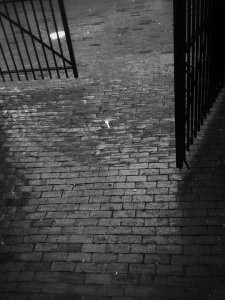Elliot Wolfson’s Reading Time (Part 1)
By Asher Crispe: July 17, 2012: Category Inspirations, Thought Figures
Whoever seeks to form an impression of historical time in everyday life may notice the wrinkles of an old man, or the scars in which a former fate is preserved. The conjunction of ruins and rebuilt sites can be recalled, noting the obvious shifts in style that lend architectural outlines their deeper temporal dimension; or one might contemplate the coexistence, connectedness, and hierarchy of variously modernized forms of transport, through which, from sleigh to airplane, entire eras meet. Above all, an individual can think of the successive generations in family or in working life, where different spaces of experience overlap and perspectives of the future intersect, including all of the conflicts with which they are invested. Even such preliminary observations make clear that the generality of a measurable time based on Nature—even if it possesses its own history—cannot be transformed unmediated into a historical concept of time.
Reinhart Koselleck (1)
To be historically means that knowledge of oneself can never be complete.
Hans-Georg Gadamer (2)
To attribute a fixed quality to time is to negate it….
Elliot R. Wolfson (3)
To what degree are we justified in applying a physical or a physicist’s concept of time to the humanities—particularly to history and historiography? In classical science, with the linear movement of the arrow of time along the causal chain, the temporal ambiguities of everyday life evaporate into the rigid and alien formalization of time as chrono-logy—the intelligibility of a sequence, the desire for order.
While the breakup of this mainstay of historical thinking in the light of classical scientific time arguably begins with Kant, it is the subsequent revolutions of Bergson, Husserl, Rosenzweig, Heidegger, Merleau-Ponty and others, that orchestrate a full blown critique, ultimately serving up a variety of viable alternatives capable of commiserating with the dynamic flux of the human subject’s internal time consciousness.
Consequent to ever more radical reformulations of a “new temporality” came a conjoined revision of history. Thus, a series of new histories or new ways of going about history grew organically alongside the rethinking of time. Yet, in no way was this transformation limited to philosophy. Science, namely physics, would experience its own radical change with respect to the most idolized common sense notions of time, giving birth to much more supple and complex conceptions. The question remains whether this “new science” (echoes to Vico intended) translates directly into the problems of the historian and the work of historical interpretation.
In this essay, I will attempt to show how this problematic underlies the prologue to Elliot R. Wolfson’s Language, Eros, Being: Kabbalistic Hermeneutics and Poetic Imagination marking what, in my view, is the most significant horizon within which to address the cutting edge of all hermeneutical problems (even more than the linguistic turn of philosophy), particularly those within the field of Jewish Mysticism.
Here, the difficulties faced in preparing a history, are intensified due to the specific tensions swollen in the belly of kabbalistic tradition and text. And while these entanglements may in the last analysis be party to a multitude of mystical religious traditions, one can safely assert that they play an undeniably pivotal role in the pursuit of progress that currently engages academic scholarship of Jewish mysticism.
Frequently employing nineteenth and twentieth century philosophy to elucidate and interpret the ideas of medieval kabbalistic texts, Wolfson provides a sustained reflection and defense against the “charge of anachronism.” (4) By arguing that “my telling of time cannot be disentangled from my time of telling” he places both the scholar and the object of scholarly research within an elastic sense of temporal openness that permits the paving of a temporal bridge between historical periods. Detached from the linear distance that separates these events, this bridge offers the option of two-way traffic at a minimal toll.
This new temporal passage–far from the sterile conditions of a positivist’s conception of a pure measurable chronology–facilitates the intra and inter-historical cross fertilization of ideas and influences, which, pushed to its logical conclusion, places all of history around a round table of discussion. While it should be pointed out that Wolfson nods with respect to “the philologist’s privileging of historical proximity” (5) he nonetheless advances towards a project of temporal non-locality fueled by the interwoven contributions of contemporary philosophy and physics. In the final analysis, I think this new endeavor “holds the promise of great discoveries” for it provides “the tools [that] have not been created” that Gershon Scholem, as Wolfson notes in his preface, sought and sent the field to seek. (6)
1 Futures Past: On the Semantics of Historical Time. p.1-2
2 Truth and Method. p. 302.
3 Language, Eros, Being. p. xxvi.
4 Language, Eros, Being: Kabbalistic Hermeneutics and Poetic Imagination. Prologue p.xv.
5 Ibid. p.xvi-xvii.
6 Ibid. p.xi.
http://www.interinclusion.org/inspirations/elliot-wolfsons-reading-time-part-2/
























;)
;)
;)
;)
;)
;)
;)
;)
;)
;)
